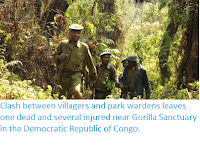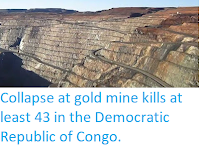Thirty eight people have now been confirmed dead in three landslides that hit Cibitoke Province in northwest Burundi on Wednesday 4 December 2019. The landslides hit the villages of Gikomero, where three people are known to have died, Rukombe, where thirteen people are known to have died, and Nyempundu, where at least twenty two people have died. All three events happened late at night when people were sleeping in their homes, making them more vulnerable to landslides hitting settlements, after several hours of severe rain in the area. Landslides are a common problem after severe weather events, as excess
pore water pressure can overcome cohesion in soil and sediments,
allowing them to flow like liquids. Approximately 90% of all landslides
are caused by heavy rainfall. Several more people are still missing in the area, with rescuers still searching the landslide sites for more bodies.
The location of Cibitoke Province. Google Maps.
The incident occurred after about a month of heavy rains, in one of the
area's two annual rainy seasons. This two rainy seasons per year pattern
is typical in equatorial
countries, with rainy seasons around the equinoxes and dry seasons
around the solstices. Upland areas of East Africa have always been prone to
landslides, but the problem has become worse in recent years as a rising
population has led to more agriculture on hill-slopes, in many areas
replacing open woodland where tree roots served to stabilise slopes, and
also to more people living in harms ways. This years rains have been exceptionally heavy, and fatalities due to similar events have also been reported in other parts
of Kenya, Somalia, Ethiopian, South Sudan, Sudan, Tanzania, the
Democratic Republic of Congo, the Republic of Congo and the Central
African Republic.
The rains this year are thought to have been made worse by the
development of a meteorological phenomenon called a Negative Indian
Ocean Dipole. Indian Ocean Dipole Phases are similar to the El Niño/La Niña
climatic oscillation that affect the Pacific Ocean. Under normal
circumstances equatorial waters off the east coast of Africa and west
coast of Indonesia are roughly similar in temperature, however during a
Negative Indian Ocean Dipole Phase the waters off the coast of Indonesia
become significantly warmer. As the prevailing currents in the area
flow west to east, this warm water is then pushed onto the shallower
continental shelf of north Australia, where it warms the air over the
sea more rapidly, leading to increased evaporation (which fuels rain)
and a drop in air pressure over the east Indian Ocean and west Pacific.
This in turn drives air currents over the Indian Ocean to flow more
strongly west to east, leading to higher rates of cooling off the coast
of Africa (where more water is drawn up from the cool sea depths) and
more warming off the coast of Indonesia, fuelling a feedback cycle that
tends to remain through the winter season in any year when it forms.
This leads to a particularly wet winter across much of Australia, as
well as a potentially damaging heatwave in the north, while much of East
Africa is at risk of drought (during a Positive Indian Ocean Dipole
Phase the reverse happens, with drought in Australia and flooding in
East Africa).
Areas of warming and cooling and air flow during a Negative Indian Ocean Dipole Phase. Australian Bureau of Meteorology.
See also...
Follow Sciency Thoughts on Facebook.








